Indigenous garden layouts beautifully connect us to cultural heritage while promoting ecological harmony. Some top designs include the Three Sisters Garden, featuring corn, beans, and squash for an integrated ecosystem, and the Medicine Wheel Garden that symbolizes balance through its circular shape. Ethnobotanical and Sacred Circle Gardens showcase significant plants and stories, while Pollinator Gardens support essential wildlife. I created Botanical Mood to explore these deep-rooted traditions, enriching our appreciation of nature's vibrant design elements. Let's discover more inspiring layouts together.
Quick Takeaways
- Traditional Agricultural Practices like the Three Sisters Garden promote biodiversity and nutritional balance through companion planting of corn, beans, and squash.
- The Medicine Wheel Garden symbolizes life balance and incorporates native plants to enhance cultural understanding and appreciation.
- Ethnobotanical Gardens showcase plant connections to cultural practices, preserving traditional knowledge while engaging the community in design and maintenance.
- Pollinator Gardens support local biodiversity by utilizing native plants to provide food and habitat for essential pollinators.
- Sacred Circle Gardens reflect the interconnectedness of life and honor significant cultural landmarks, fostering community engagement and education.
Three Sisters Garden
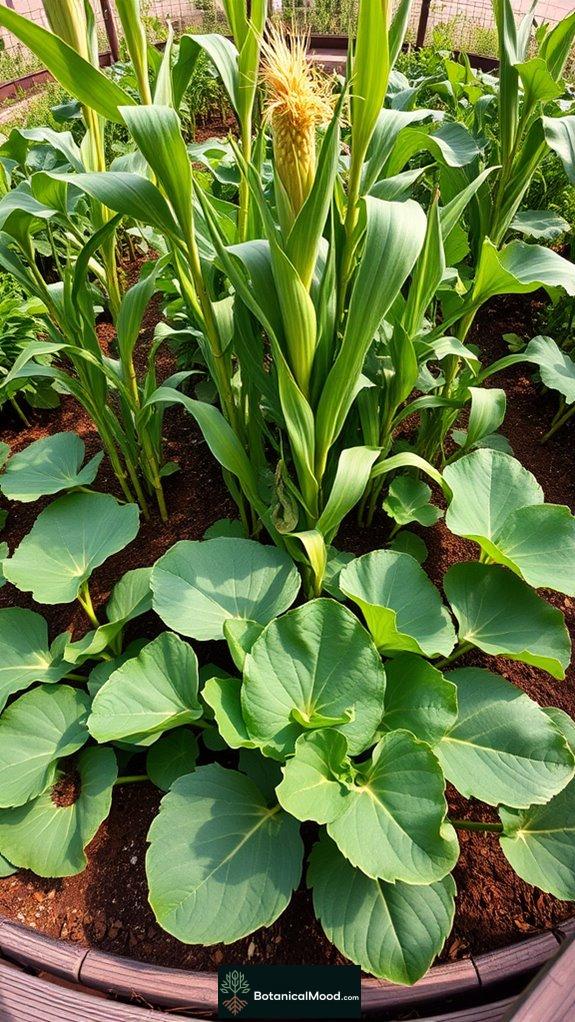
One of the most fascinating gardening concepts I've come across is the Three Sisters garden, a traditional practice that indigenous peoples have nurtured for centuries.
This beautiful arrangement features corn, beans, and squash, each complementing the others in a symbiotic dance. Corn stands tall, providing support, while beans enrich the soil with nitrogen, and squash blankets the ground, suppressing weeds. The Three Sisters together, they create a harmonious ecosystem, rich in nutrition and biodiversity.
I created Botanical Mood to inspire others to explore these timeless practices, inviting you to engage with nature and honor the cultural significance behind these gardens that have thrived for generations.
Medicine Wheel Garden

Having explored the interconnectedness of plants in the Three Sisters garden, it's fascinating to contemplate another indigenous gardening practice: the Medicine Wheel garden.
This circular design, divided into four quadrants, symbolizes the balance of life and our connection to the universe. Each direction embodies a season and element, using native plants chosen for their cultural significance and vibrant colors.
Imagine walking paths made from natural materials, guiding you through a space that nurtures both body and spirit.
I created Botanical Mood to share the beauty of these gardens, fostering deeper understanding and appreciation of indigenous cultural connections.
Ethnobotanical Garden
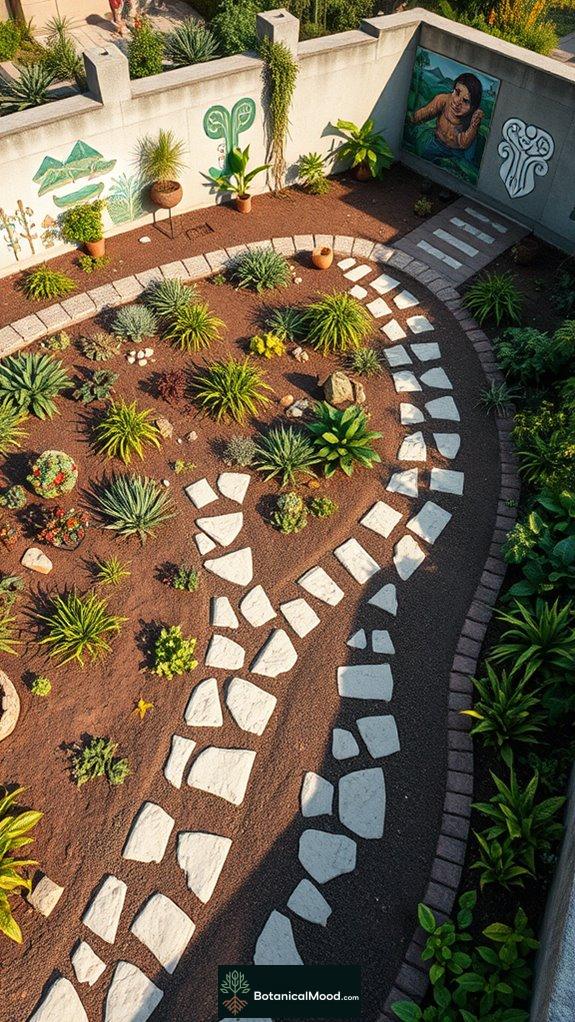
Ethnobotanical gardens, which showcase the deep connections between plants and cultural practices, offer a unique glimpse into the ways diverse societies interact with their natural environment. These living museums inspire us and serve educational purposes.
Here are four reasons to appreciate them:
- They preserve traditional knowledge about plant uses.
- The gardens often feature thematic zones for food, medicine, crafts, and symbolism.
- Community members engage in their design and maintenance.
- Artistic elements, like murals, enrich the storytelling of cultural traditions.
Additionally, these gardens embody regenerative planting techniques that promote sustainable ecosystem practices. I created Botanical Mood to celebrate the beauty of these vibrant spaces, inviting you to explore their significance.
Sacred Circle Garden

The Sacred Circle Garden, nestled in the breathtaking Black Hills region of South Dakota, serves as a vibrant symbol of the enduring connection between indigenous cultures and their land.
Designed through the wisdom of tribal elders, this garden features a central medicine wheel, reflecting the circularity of life and unity. Native grasses and plants create a harmonious environment that honors significant landmarks like Mato Paha and Bear Butte.
I created this website, Botanical Mood, to share such intimate connections. Here, community members and students engage in educational events, fostering a deeper understanding of local culture while preserving the rich history of the Black Hills.
Pollinator Garden
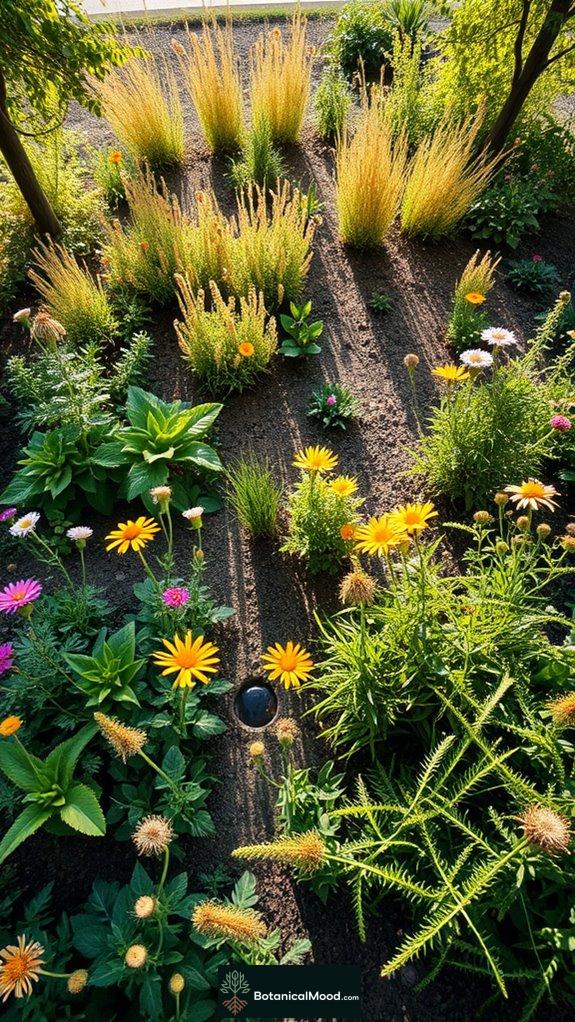
Pollinator gardens not only enhance the beauty of our environments but also play an indispensable role in supporting the important ecosystem of local pollinators.
I love creating spaces that invite bees, butterflies, and other pollinators to thrive. Here are a few key elements I focus on:
- Native Plants: They provide the best food and habitat.
- Diversified Blooms: Variety attracts more pollinators.
- Plant Grouping: Clustering plants makes them easier to find.
- Water Sources: Accessible water is crucial for their health.
In addition, incorporating native bee and butterfly garden layouts can significantly improve the overall functionality and beauty of your garden design.
Rain Garden

Creating vibrant outdoor spaces doesn't stop with inviting pollinators; it also extends to managing rainwater effectively.
Rain gardens, those beautiful shallow depressions, capture and filter rainwater runoff, helping to mitigate flooding while enhancing water quality. I love placing them strategically, usually lower than surrounding areas, to naturally collect water.
Using native plants, I create habitats that attract wildlife, bringing life to my garden. Each garden tells a story, connecting us to nature and the essential role of water in our ecosystems. Implementing sustainable water conservation techniques can further enhance the effectiveness of these gardens.
At Botanical Mood, I cherish sharing these designs that foster both beauty and environmental harmony.
Food Forest

Food forests offer a harmonious blend of beauty and functionality, transforming ordinary spaces into thriving ecosystems.
These gardens aren't just about food; they celebrate culture, biodiversity, and sustainability.
Here are some key features of a food forest:
- Layered Structures: Tall trees, shrubs, herbs, and ground covers create a rich tapestry.
- Native Species: I focus on selecting plants that nourish both the land and the community.
- Sustainable Practices: Techniques like rainwater harvesting minimize our ecological footprint.
- Cultural Significance: Each plant tells a story, connecting us to ancestral wisdom and local biodiversity. Additionally, incorporating modern permaculture strategies enhances the resilience and productivity of these ecosystems.
Community Gathering Space
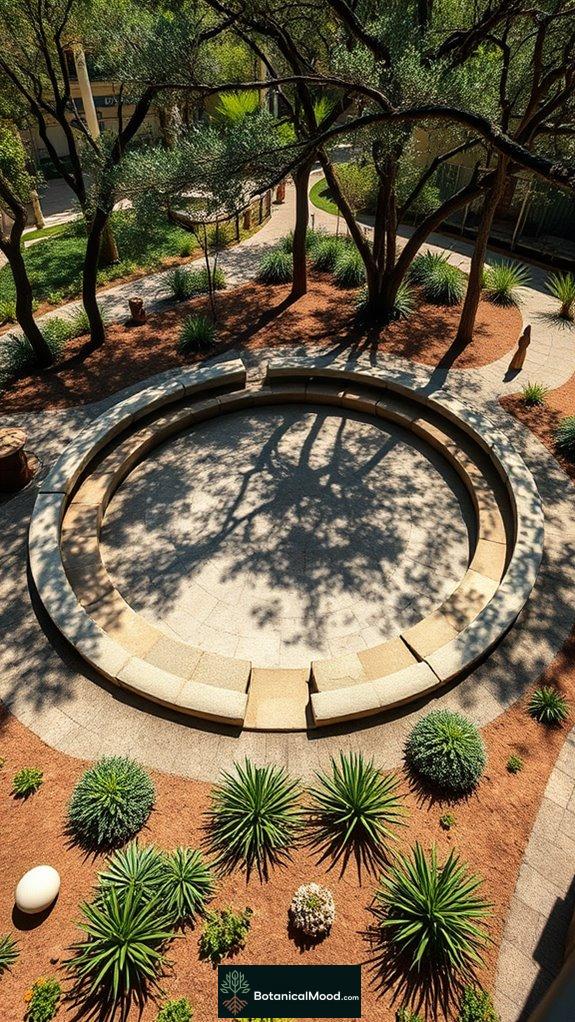
A well-designed community gathering space serves as the heart of any Indigenous garden, fostering connections among people and nature.
Incorporating circular gathering areas, these spaces echo traditional communal settings, inviting storytelling and performances.
I love how seating options cater to both large and small groups, encouraging rich conversations.
Cultural artwork, like murals and sculptures, adds a vibrant touch, celebrating Indigenous themes.
Seasonal Harvest Garden
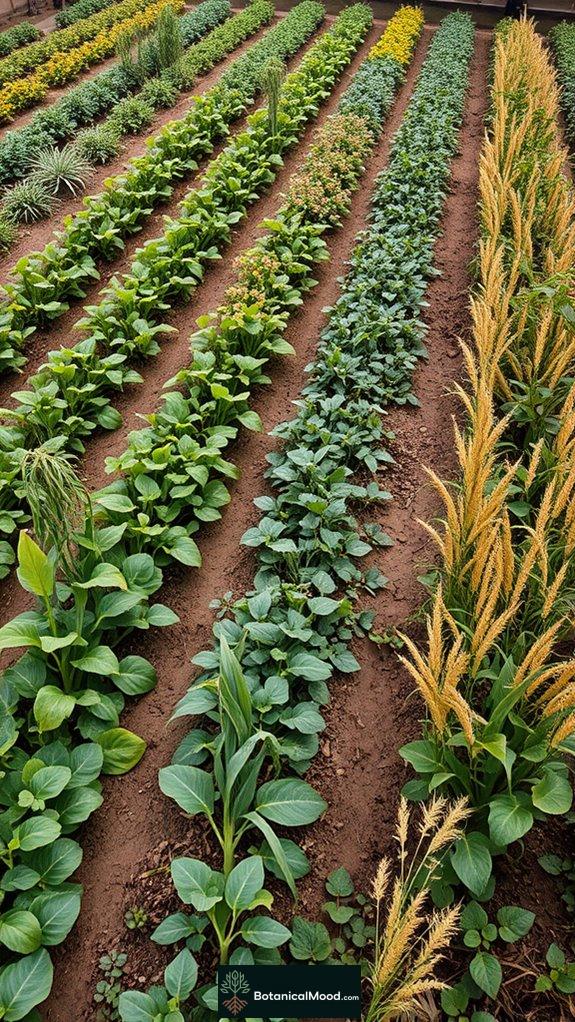
Indigenous gardens not only celebrate community but also embody the rhythms of nature through seasonal harvest gardens.
I cherish the beauty and diversity these gardens bring, where each season tells its own story.
Here are some key elements to ponder:
- Crop Rotation: Rotate your crops to enhance soil health and maximize yields.
- Multi-Crop Planting: Use the Three Sisters method for mutual support among plants.
- Succession Planting: Guarantee a steady supply of fresh produce throughout the year.
- Local Adaptation: Adjust planting schedules based on local climate for ideal growth.
Additionally, incorporating companion planting strategies can further boost the health and productivity of your garden.
At Botanical Mood, I connect with these traditions, celebrating the rich cultural heritage of gardening.
Native Plant Habitat

Creating a native plant habitat is an enriching endeavor that not only beautifies our surroundings but also fosters a deeper connection with the environment. These gardens invite life, support biodiversity, and honor cultural traditions. Additionally, they are crucial for pollinator support, as they provide essential resources for bees, butterflies, and other beneficial insects.
| Benefits | Details |
|---|---|
| Water Conservation | Native plants need less water, reducing waste. |
| Wildlife Support | They provide food and shelter for local fauna. |
| Cultural Significance | Integral to indigenous practices and heritage. |
| Soil Health | Deep roots enhance soil's capacity for water. |
I created Botanical Mood to share the beauty of these gardens, hoping to inspire you to connect with nature deeply.
Traditional Agricultural Mounds
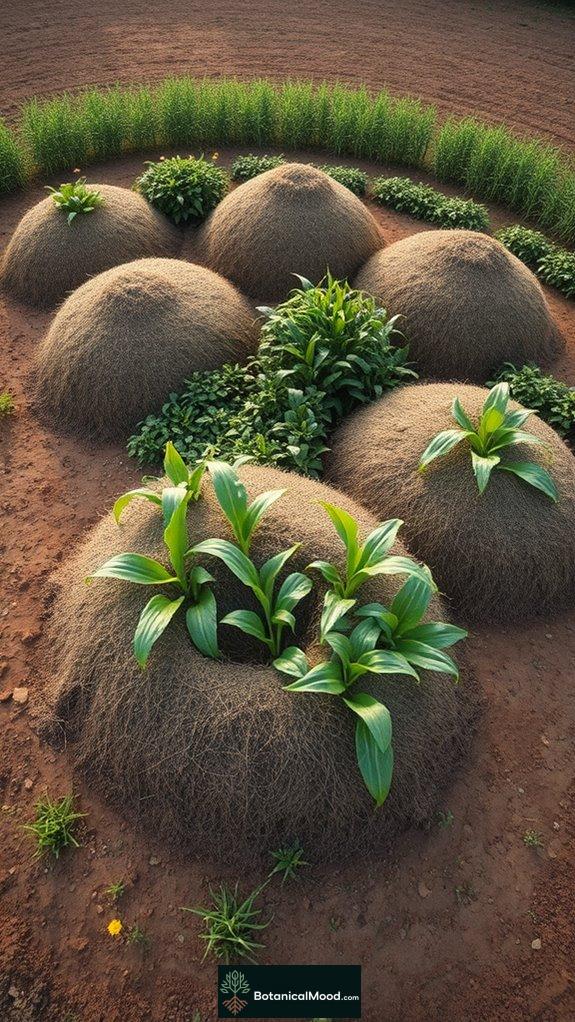
Traditional agricultural mounds represent a remarkable intersection of design and functionality, showcasing the ingenuity of ancient farming practices.
These mounds, with their unique structure, offer numerous benefits:
- They maximize space by allowing crops like corn, beans, and squash to thrive together.
- The design enriches soil fertility through nitrogen fixation from beans.
- Squash suppresses weeds and retains moisture, creating a sustainable environment.
- This method fosters community engagement, as gardening often becomes a collective effort.
I created Botanical Mood to celebrate these beautiful practices, helping others reconnect with the land and its rich heritage through mindful gardening. Additionally, incorporating companion planting techniques can further enhance the benefits of traditional agricultural mounds.
Cultural Storytelling Pathway
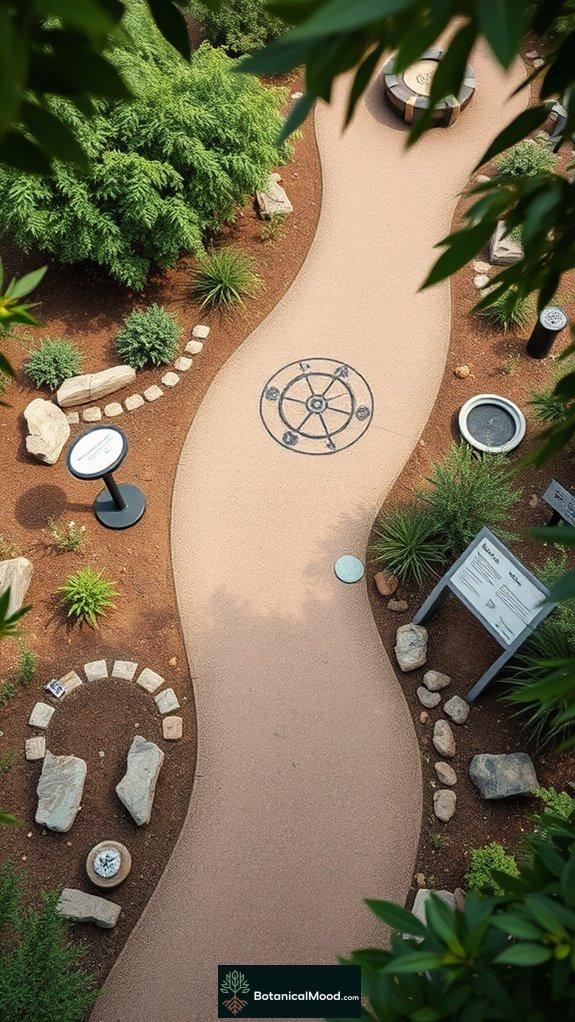
When you step onto a cultural storytelling pathway, you're not just walking through a garden; you're entering a space where history, heritage, and community converge.
Each twist and turn invites you to reflect on significant events, like treaties and residential schools, marked by educational signs and QR codes that deepen your understanding.
The circular designs, inspired by the Medicine Wheel, emphasize our interconnectedness and unique roles within the community.
As you walk, you'll discover symbolic elements and plants that hold cultural importance, fostering a sense of healing and connection.
This journey nurtures my passion for sharing Indigenous wisdom through Botanical Mood.
Indigenous Plant Arrangement Strategies
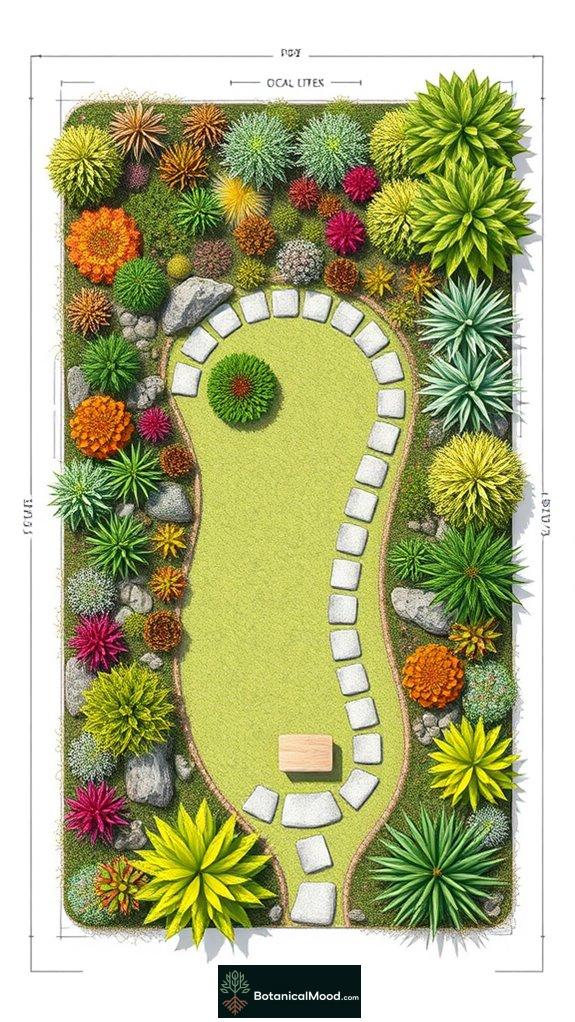
Indigenous gardens resonate with the stories of the land and its people, where plant arrangements serve not only as aesthetic features but also as a bridge to cultural heritage.
Here are some strategies I find impactful:
- Integrate local environments, ensuring native plants thrive without competition.
- Engage with Traditional Owners to maintain cultural relevance.
- Choose diverse native plants for ecological harmony and year-round interest.
- Create visual interest through tiered arrangements and focal points.
Through my website, Botanical Mood, I hope to inspire you to embrace these strategies, cultivating not just gardens but connections to our shared history.
Cultural Symbolism in Garden Design
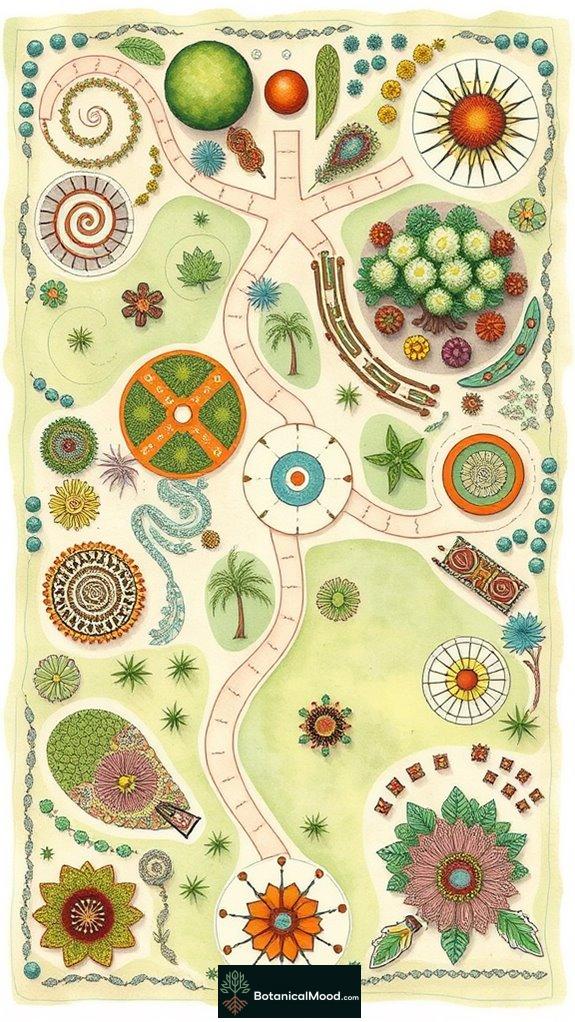
Cultural symbolism in garden design breathes life into the spaces we cultivate, transforming them into reflections of our values, beliefs, and histories.
Every element, from the graceful curves of pathways to the vibrant colors of blooming plants, serves a purpose. Geometric patterns evoke harmony, while water features symbolize transformation and renewal. Entrances adorned with mythical creatures invite us into sacred domains, and trees stand as symbols of strength and longevity.
Through my website, Botanical Mood, I aim to connect you with these rich traditions, encouraging you to create gardens that resonate with your own cultural stories and inspire a deeper connection to nature.
Indigenous Garden Spatial Organization

Gardens aren't just spaces filled with plants; they're thoughtfully arranged environments that reflect the unique stories of their caretakers. In Indigenous garden spatial organization, I find a deep connection to history and culture.
Here are some key elements I cherish:
- Scale Sensitivity – Gardens should harmonize with their surroundings.
- Odd Number Grouping – Planting in odd numbers creates visual balance.
- Wild Aesthetic – Embracing nature's wildness while maintaining some order.
- Cultural Adaptation – Designs should reflect regional practices and values.
Through Botanical Mood, I aim to share this beauty and cultural significance with others.
Creating Functional Plant Zones

When designing a garden, understanding how to create functional plant zones can truly transform the space into a harmonious ecosystem. By thoughtfully layering plants, we can enhance beauty while supporting wildlife. For instance, I love using groundcovers like sedges and ferns that not only reduce weeds but also invite biodiversity.
| Plant Type | Examples | Benefits |
|---|---|---|
| Groundcovers | Bicknell's Sedge, Ferns | Weed suppression, texture |
| Structural Plants | Red Chokeberry, Dogwood | Year-round interest |
| Seasonal Layers | Virginia Bluebells, Phlox | Pollinator attraction |
Creating these zones brings balance and life to our gardens.
References
- https://www.nativeseeds.org/blogs/blog-news/how-to-grow-a-three-sisters-garden
- https://www.motherearthnews.com/organic-gardening/native-american-gardening-zm0z13fmzsto/
- https://www.almanac.com/content/three-sisters-corn-bean-and-squash
- https://www.uaex.uada.edu/counties/white/news/horticulture/20210511Creating_Three_Sisters_Garden.aspx
- https://gardenbetty.com/planting-a-three-sisters-garden/
- https://missionzero.sheridancollege.ca/biodiversity/medicine-wheel-garden-project/
- https://www.gardeningknowhow.com/garden-how-to/design/lideas/medicine-wheel-garden-ideas.htm
- https://greenriverpreserve.org/blog/2024/6/grp-garden-project-the-medicine-wheel
- https://www.returnofthenative.ca/snippets/7-blog/217-the-medicine-wheel-garden-at-maple-grove-public-school
- https://livingnatureslove.wordpress.com/2017/03/05/medicine-wheel-garden-design-placement/

Leave a Reply